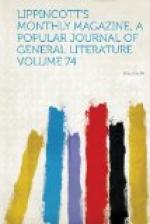[Illustration: MARBLE STAIRCASE, PALACE OF BESKIK-TASCH.]
Of course we paid a visit to Seraglio Point, whose palmy days, however, have passed away. The great fire of 1865 burned the palace, a large district on the Marmora, and swept around the walls of St. Sophia, leaving the mosque unharmed, but surrounded by ruins. The sultan never rebuilds: it is not considered lucky to do so. Indeed, he is said to believe that if he were to stop building he would die. Seraglio Point has been abandoned by the court, and the sultan lives in a palace on the Bosphorus, and one of the loveliest spots on earth is left to decay. We entered through the magnificent gate of the Sublime Porte, passed the barracks, which are still occupied by the soldiers, visited the arsenal and saw the wax figures of the Janizaries and others in Turkish costume. The upper part of the pleasure-grounds is in a neglected state, and those near the water are entirely destroyed. In one of the buildings are the crown-jewels and a valuable collection of other articles. There were elegant toilet sets mounted in gold; the most exquisitely delicate china; daggers, swords and guns of splendid workmanship and sparkling with jewels; Chinese work and carving; golden dishes, cups and vases, and silver pitchers thickly encrusted with precious stones; horse trappings and velvet hangings worked stiff with pearls, gold and silver thread, bits of coral, and jewels; three emeralds as large as small hen’s eggs, forming the handle of a dirk; and in a large glass case magnificent ornaments for the turban. There must have been thousands of diamonds in these head-pieces, besides some of the largest pearls I have ever seen; a ruby three-quarters of an inch square; four emeralds nearly two inches long; and a great variety of all kinds of precious stones. The handle and sheath of one sword were entirely covered with diamonds and rubies. There were rings and clasps, and antique bowls filled with uncut stones, particularly emeralds. It recalled the tales of the Arabian Nights. The collection is poorly arranged, and the jewels dusty, so that you cannot examine closely or judge very well of the quality. Those I have mentioned interested me most, but there were many elegant articles of European manufacture which had been presented to the sultan by various monarchs. Near the treasury is a very handsome pavilion, built of white marble, one story high, with fine large plate-glass windows. A broad hall runs through the centre, with parlors on each side. The walls were frescoed, and on the handsomely-inlaid and highly-polished floors were beautiful rugs. The divans were gilt and heavy silk damask—one room crimson, one blue and another a delicate buff. A few large vases and several inlaid Japanese cabinets completed the furniture: the Koran does not allow pictures or statuary. The view from the windows, and especially from the marble terrace in front, is one of the finest I have ever seen. The pavilion stands on the highest




